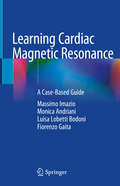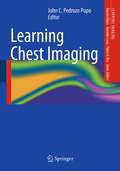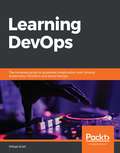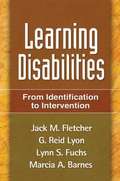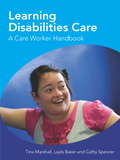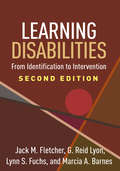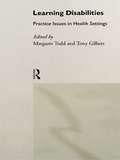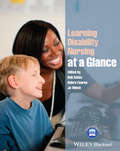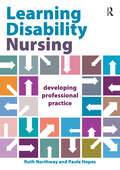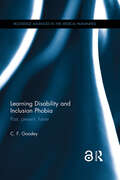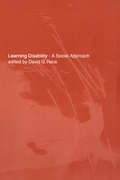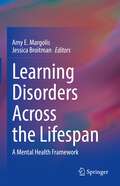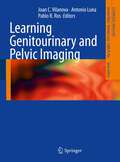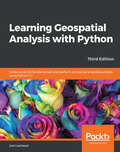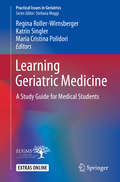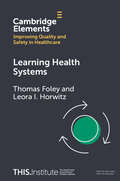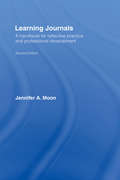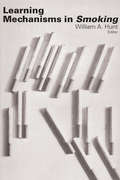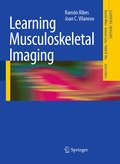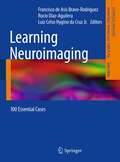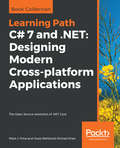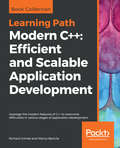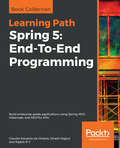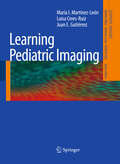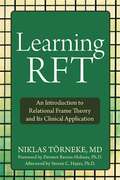- Table View
- List View
Learning Cardiac Magnetic Resonance: A Case-Based Guide
by Massimo Imazio Monica Andriani Fiorenzo Gaita Luisa Lobetti BodoniThis book provides an easy-to-use guide, giving cardiologists and other physicians more confidence in training with and understanding cardiac magnetic resonance (CMR) in clinical daily practice. The case-based format promotes step-by-step learning and makes this book a helpful tool for students, residents and trainees in cardiology. An updated, comprehensive review of CMR diagnostic criteria is provided for all clinical cardiovascular applications of CMR in adult patients, from ischemic heart diseases to myocarditis, and from pericardial diseases to tumors, artifacts and incidental findings. CMR is an expanding imaging technique for cardiologists and radiologists alike. Despite several textbooks, manuals and dedicated texts, clinicians may still find it difficult to familiarize themselves with the exam and there are limited formats that provide easy access to the basic information (e.g. physics, specific applications) that are needed for training and clinical interpretation (especially case-based). By describing the basics of physics and methodology in a straightforward manner and providing meaningful clinical examples, this book will help all cardiologists dealing with cardiac imaging as well as doctors in training to quickly and accurately interpret CMR findings in their clinical practice.
Learning Chest Imaging
by John C. Pedrozo PupoRadiology of the thorax forms an indispensable element of the basic diagnostic process for many conditions and is of key importance in a variety of medical disciplines. This user-friendly book provides an overview of the imaging techniques used in chest radiology and presents numerous instructive case-based images with accompanying explanatory text. A wide range of clinical conditions and circumstances are covered with the aim of enabling the reader to confidently interpret chest images by correctly identifying structures of interest and the causes of abnormalities. This book, which will be an invaluable learning tool, forms part of the Learning Imaging series for medical students, residents, less experienced radiologists, and other medical staff.
Learning DevOps: The complete guide to accelerate collaboration with Jenkins, Kubernetes, Terraform and Azure DevOps
by Mikael KriefSimplify your DevOps roles with DevOps tools and techniques Key Features Learn to utilize business resources effectively to increase productivity and collaboration Leverage the ultimate open source DevOps tools to achieve continuous integration and continuous delivery (CI/CD) Ensure faster time-to-market by reducing overall lead time and deployment downtime Book Description The implementation of DevOps processes requires the efficient use of various tools, and the choice of these tools is crucial for the sustainability of projects and collaboration between development (Dev) and operations (Ops). This book presents the different patterns and tools that you can use to provision and configure an infrastructure in the cloud. You'll begin by understanding DevOps culture, the application of DevOps in cloud infrastructure, provisioning with Terraform, configuration with Ansible, and image building with Packer. You'll then be taken through source code versioning with Git and the construction of a DevOps CI/CD pipeline using Jenkins, GitLab CI, and Azure Pipelines. This DevOps handbook will also guide you in containerizing and deploying your applications with Docker and Kubernetes. You'll learn how to reduce deployment downtime with blue-green deployment and the feature flags technique, and study DevOps practices for open source projects. Finally, you'll grasp some best practices for reducing the overall application lead time to ensure faster time to market. By the end of this book, you'll have built a solid foundation in DevOps, and developed the skills necessary to enhance a traditional software delivery process using modern software delivery tools and techniques What you will learn Become well versed with DevOps culture and its practices Use Terraform and Packer for cloud infrastructure provisioning Implement Ansible for infrastructure configuration Use basic Git commands and understand the Git flow process Build a DevOps pipeline with Jenkins, Azure Pipelines, and GitLab CI Containerize your applications with Docker and Kubernetes Check application quality with SonarQube and Postman Protect DevOps processes and applications using DevSecOps tools Who this book is for If you are a developer or a system administrator interested in understanding continuous integration, continuous delivery, and containerization with DevOps tools and techniques, this book is for you.
Learning Disabilities
by G. Reid Lyon Jack FletcherEvidence based and comprehensive, this important work offers a new approach to understanding and intervening with students with learning disabilities. The authors--leading experts in neuropsychology and special education--present a unique model of learning disabilities that integrates the cognitive, neural, genetic, and contextual factors associated with these disorders. The volume addresses classification, assessment, and intervention for a range of disabilities involved in reading, mathematics, and written expression. With a focus on exploring the evolving scientific base of the field, as well as establishing effective educational practices, this book will serve as an essential text and an indispensable resource for school psychologists, neuropsychologists, special educators, and others who work with struggling learners.
Learning Disabilities Care A Care Worker Handbook
by Tina Marshall Layla BakerWorking with people with Learning Disabilities? Training in Learning Disabilities care? You don't have to go it alone!Caring for people with Learning Disabilities is one of the most challenging and rewarding roles in Health and Social Care. But with a range of awards, certificates and pathways available to work-based learners it can be a confusing area. That's why we've put together a one-stop handbook to support your training and continuing professional development in caring for people with learning disabilities.Here in one place is all the topic knowledge, assessment support and practical advice you will need for a range of learning disabilities qualifications. Core topics are linked to the specific learning and assessment objectives you need to cover for up to 22 QCF units. Case studies tie learning into the many different situations and roles across Home Care, Residential Care, NHS and Private Settings.This book is especially useful for candidates taking the: Level 2 Award in Learning Disabilities Level 2 Certificate in Learning Disabilities Level 3 Award in Learning Disabilities Level 3 Certificate in Learning DisabilitiesIt's also a must have reference for those who want to brush up skills and knowledge from previous qualifications.So whatever your level of specialism, give yourself the tools you need to survive and support your clients with learning disabilities.
Learning Disabilities, Second Edition: From Identification to Intervention
by Marcia A. Barnes G. Reid Lyon Jack M. Fletcher Lynn S. FuchsReviewing the state of the science of learning disabilities (LDs) and describing effective educational practices, this authoritative volume has been significantly revised and expanded with more than 70% new material. Foremost LD experts identify effective principles of assessment and instruction within the framework of multi-tiered systems of support (MTSS). With a focus on what works in the classroom, the book explores the full range of reading, mathematics, and writing disabilities. It synthesizes knowledge from neuropsychology, cognitive neuroscience, and special and general education. Illustrations include eight color plates. As a special supplement, a chapter on the history of the LD field from the first edition is provided at the companion website. New to This Edition *Heightened emphasis on intervention, including significant new developments in reading comprehension and math. *Reflects major scientific advances in understanding LDs. *Chapter on principles of effective instruction and MTSS. *Chapter on automaticity in reading, math, and writing. *Chapter on challenges in real-world implementation of evidence-based practices. *Chapter on the validity of the LD construct.
Learning Disabilities: Practice Issues in Health Settings
by Margaret Todd Tony GilbertLearning Disabilities raises issues which are of crucial importance to all health care professionals and students who work with people with a learning disability. The authors, senior nurse teachers and practitioners in the field, examine these issues, and the theoretical concepts underpinning them, from a practical perspective. They show how complex and interconnecting ideas such as consumerism and choice, control and empowerment, informed choice and professional power can be applied with real understanding. Learning Disabilities includes* introductions and explanations of key concepts* practical guidelines for care delivery* detailed case studies* useful summaries of key points
Learning Disability Nursing at a Glance
by Jo Welch Debra Fearns Bob GatesLearning Disability Nursing at a Glance is the perfectcompanion for study and revision from the publishers of themarket-leading at a Glance series. This visual, dynamic anduser-friendly resource addresses the key principles underpinningcontemporary learning disability nursing practice, relates them tokey clinical practice issues, and explores them in the context ofmaintaining health and well-being. Exploring the full spectrum of care, this textbook addresses theneeds of people with learning disabilities across the life span,from children through to adolescents and on to adults and olderpeople. Aimed at nursing, health and social care students, as wellas registered nurses, this is an invaluable resource for all thoselooking to consolidate and expand their knowledge, in order toprovide safe, effective and compassionate care to people withlearning disabilities.The perfect revision and consolidation textbookHighly visual colour presentation, with full colourillustrations throughoutIncludes expert contributions from learning disability academicstaff as well as cliniciansEmbraces both primary and secondary care perspectivesSupported by a companion website featuring case studies tofurther test your knowledgeAvailable in a range of digital formats- perfect for 'onthe go' study and revision
Learning Disability Nursing: Developing Professional Practice
by Ruth Northway Paula HopesExplores all aspects of professional development in learning disability nursing from the foundations to advanced practice. Key themes running through the book include the importance of a human rights and values-based approach, the development of person-centred approaches to care and support, and the need to work in partnership with key stakeholders, including people with learning disabilities and their families. It encourages readers to make links between theory and practice and to develop their skills in critical thinking through case studies and reflective activities.This is a must-have book for all undergraduate nurses studying to become Registered Nurses (Learning Disability), specifically linked to achieving the outcomes required within the NMC Standards for Nurse Education (2018).It is also of relevance to qualified learning disability nurses, those studying to become Registered Nurses (Intellectual Disabilities) in Ireland, as well as nursing students in general who should have a good working knowledge of learning disability practice.
Learning Disability and Inclusion Phobia: Past, Present, Future (Routledge Advances in the Medical Humanities)
by C. F. GoodeyThe social position of learning disabled people has shifted rapidly over the last 20 years, from long-stay institutions, first into community homes and day centres, and now to a currently emerging goal of "ordinary lives" for individuals using person-centred support and personal budgets. These approaches promise to replace a century and a half of "scientific" pathological models based on expert assessment, and of the accompanying segregated social administration which determined how and where people led their lives, and who they were. This innovative volume explains how concepts of learning disability, intellectual disability and autism first came about, describes their more recent evolution in the formal disciplines of psychology, and shows the direct relevance of this historical knowledge to present and future policy, practice and research. Goodey argues that learning disability is not a historically stable category and different people are considered "learning disabled" as it changes over time. Using psychological and anthropological theory, he identifies the deeper lying pathology as "inclusion phobia", in which the tendency of human societies to establish an in-group and to assign out-groups reaches an extreme point. Thus the disability we call "intellectual" is a concept essential only to an era in which to be human is essentially to be deemed intelligent, autonomous and capable of rational choice. Interweaving the author's historical scholarship with his practice-based experience in the field, Learning Disability and Inclusion Phobia challenges myths about the past as well as about present-day concepts, exposing both the historical continuities and the radical discontinuities in thinking about learning disability.
Learning Disability: A Social approach
by David G. RaceThe detailed study of learning disability features rarely in university courses. To a large extent this reflects the low value attributed by our society and its human services to people with learning difficulties. This unusual book, based on one of those rare courses, includes contributions from academic specialists, students and people with learning difficulties, all of whom have participated in the course. Its 'social approach' challenges the very idea of what should be taught about the subject of learning disability and who should teach it. Learning Disability - A Social Approach looks at how people's lives are affected by human services. It covers specific policy and service issues, different aspects of working with people and key debates. The unique insights gained from the combination of academic knowledge and real life experience make it a topical and thought-provoking text for anyone involved with learning disability - student, teacher, professional or policy maker.
Learning Disorders Across the Lifespan: A Mental Health Framework
by Jessica Broitman Amy E. MargolisThis book addresses the need to view specific learning disorders (SLDs) within a mental health framework, as supported by their placement alongside autism spectrum disorder (ASD) and attention deficit hyperactivity disorder (ADHD) in the Diagnostic and Statistical Manual of Mental Disorders, Fifth Edition (DSM-5). It describes how policy and practice point to a different perspective – specifically that SLDs are often treated as educational rather than psychological problems – and examines the implications of this dichotomy. The book reviews empirical research that suggests children need access to treatment for clinical components of SLDs that may respond to psychological intervention separately from, and in addition to, educational interventions. It provides a theoretical framework for organizing research findings and clinical perspectives that support understanding the clinical components of SLDs and addresses the need for a mental health framework within which to approach theory, treatment, and assessment of SLDs.Key areas of coverage include:Examining different theoretical orientations to learning disorders (e.g., cognitive, behavioral, neuropsychoeducational, psychoanalytic).Adapting evidence-based therapeutic techniques for use with children and adolescents who have learning disorders.The need for accurate and well characterized assessment of SLDs.How incorporating a cognitive neuroscience perspective into assessment can move LD treatment and research forward.Learning Disorders Across the Lifespan is an essential reference for clinicians, therapists, and other professionals as well as researchers, professors, and graduate students in school and clinical child psychology, special education, speech-language therapy, developmental psychology, pediatrics, social work as well as all interrelated disciplines.
Learning Genitourinary and Pelvic Imaging
by Joan C. Vilanova Antonio Luna Pablo R. RosThis introduction to genitourinary and pelvic radiology is a further volume in the Learning Imaging series. Written in a case-based format, the book is subdivided into ten chapters: kidney; adrenal gland; urinary bladder, collecting system and urethra; prostate and seminal vesicles; scrotum; obstetrics; uterus; cervix and vagina; adnexa and retroperitoneum. Genitourinary radiology has undergone a tremendous change owing to advances in ultrasound, CT and MRI that have redefined our understanding of genitourinary and pelvic pathology. Each chapter includes an introduction and ten case studies with illustrations and comments from anatomical, physiopathological and radiological standpoints and with bibliographic recommendations.
Learning Geospatial Analysis with Python: Understand GIS fundamentals and perform remote sensing data analysis using Python 3.7, 3rd Edition
by Joel LawheadLearn the core concepts of geospatial data analysis for building actionable and insightful GIS applications Key Features Create GIS solutions using the new features introduced in Python 3.7 Explore a range of GIS tools and libraries such as PostGIS, QGIS, and PROJ Learn to automate geospatial analysis workflows using Python and Jupyter Book Description Geospatial analysis is used in almost every domain you can think of, including defense, farming, and even medicine. With this systematic guide, you'll get started with geographic information system (GIS) and remote sensing analysis using the latest features in Python. This book will take you through GIS techniques, geodatabases, geospatial raster data, and much more using the latest built-in tools and libraries in Python 3.7. You'll learn everything you need to know about using software packages or APIs and generic algorithms that can be used for different situations. Furthermore, you'll learn how to apply simple Python GIS geospatial processes to a variety of problems, and work with remote sensing data. By the end of the book, you'll be able to build a generic corporate system, which can be implemented in any organization to manage customer support requests and field support personnel. What you will learn Automate geospatial analysis workflows using Python Code the simplest possible GIS in just 60 lines of Python Create thematic maps with Python tools such as PyShp, OGR, and the Python Imaging Library Understand the different formats that geospatial data comes in Produce elevation contours using Python tools Create flood inundation models Apply geospatial analysis to real-time data tracking and storm chasing Who this book is for This book is for Python developers, researchers, or analysts who want to perform geospatial modeling and GIS analysis with Python. Basic knowledge of digital mapping and analysis using Python or other scripting languages will be helpful.
Learning Geriatric Medicine: A Study Guide For Medical Students (Practical Issues in Geriatrics)
by Regina Roller-Wirnsberger Katrin Singler Maria Cristina PolidoriThis textbook presents hands-on training material for medical students. The style reflects the need for practice-based teaching with a modern edge in daily clinical routine; accordingly, it also employs online material and pocket cards. Each chapter begins with specific learning objectives, which are cross-referenced with the European curriculum for undergraduate medical education released by the European Union of Medical Specialists (UEMS) together with the European Union Geriatric Medicine Society (EUGMS), as well as the minimum geriatric competences for medical students established by the American Geriatrics Society (AGS). World-renowned European experts in practicing and teaching the interdisciplinary field of Geriatrics contributed to this work, with the aim of offering the new generation of health professionals a global perspective on one of the greatest public health challenges of our time: the management of the steadily increasing number of older, multimorbid, and vulnerable persons. The major strength of this book – published under the auspices of the EUGMS – is its pragmatic, goal-oriented approach, which makes it suitable for bedside learning and patient-centered medicine; further, all of the chapters are firmly based on the pillars of the ageing process in all of its biological aspects, helping readers understand the pathophysiology of and rationale behind interventions for the main geriatric syndromes and disorders.
Learning Health Systems (Elements of Improving Quality and Safety in Healthcare)
by Thomas Foley Leora I. HorwitzDespite enormous efforts at healthcare improvement, major challenges remain in achieving optimal outcomes, safety, cost, and value. This Element introduces the concept of learning health systems, which have been proposed as a possible solution. Though many different variants of the concept exist, they share a learning cycle of capturing data from practice, turning it into knowledge, and putting knowledge back into practice. How learning systems are implemented is highly variable. This Element emphasises that they are sociotechnical systems and offers a structured framework to consider their design and operation. It offers a critique of the learning health system approach, recognising that more has been said about the aspiration than perhaps has been delivered. This title is also available as open access on Cambridge Core.
Learning Journals: A Handbook for Reflective Practice and Professional Development
by Jennifer A. MoonFully updated with important new theory and practical material, this second edition of Learning Journals offers guidance on keeping and using journals and gives step-by-step advice on integrating journal writing on taught courses, in training and professional development and in supporting personal development planning (PDP) activities. Key topics covered include: the nature of learning journals and how we learn from them the broad range of uses of learning journals, including portfolios and personal and professional development the depth and quality of reflection in learning journals the assessment of learning journals and reflective writing the use of narrative and story-telling techniques in journals. With useful exercises and activities that enhance learning journal work in a structured manner, Learning Journals is invaluable reading for teachers and students in higher education, for all professionals, particularly those working in the health services and business and training and for all those who want to learn more about keeping a fulfilling personal journal.
Learning Mechanisms in Smoking
by William A. HuntPsychologists have spent years studying the learning processes of the white rat, yet until recently they have neglected the laboratory of everyday social behavior for studying learning in man. In this book the leading experts in learning theory and pharmacology examine the role of learning mechanisms in smoking. The results provide new insights into the study of learning and determine new directions for future research on smoking and its control.
Learning Musculoskeletal Imaging
by Ramón Ribes Joan C. VilanovaThis introduction to musculoskeletal imaging is a further volume in the Learning Imaging series. Written in a user-friendly format, it takes into account that musculoskeletal radiology is a subspecialty which has widely expanded its scope and imaging capabilities with the advent of ultrasound, MRI, multidetector CT, and PET. The book is divided into ten sections covering: infection and arthritis, tumors, tendons and muscles, bone marrow, spine, shoulder, elbow, hand and wrist, hip and pelvis, knee, and ankle and foot. Each chapter is presented with an introduction and ten case studies with illustrations and comments from anatomical, physiopathological and radiological standpoints along with bibliographic recommendations.
Learning Neuroimaging
by Francisco de Bravo-Rodríguez Luiz Celso Hygino Da Cruz Jr. Rocío Diaz-AguileraThis book is intended as an introduction to neuroradiology and aims to provide the reader with a comprehensive overview of this highly specialized radiological subspecialty. One hundred illustrated cases from clinical practice are presented in a standard way. Each case is supported by representative images and is divided into three parts: a brief summary of the patient's medical history, a discussion of the disease, and a description of the most characteristic imaging features of the disorder. The focus is not only on common neuroradiological entities such as stroke and acute head trauma but also on less frequent disorders that the practitioner should recognize. Learning Neuroimaging: 100 Essential Cases is an ideal resource for neuroradiology and radiology residents, neurology residents, neurosurgery residents, nurses, radiology technicians, and medical students.
Learning Path - C# 7 and .NET: The Open Source Revolution Of . Net Core
by Mark J. Price Ovais Mehboob KhanThis Learning Path is designed for developers who want to gain a solid foundation with C# and .NET Core, and want to build cross-platform applications. To gain maximum benefits from this Learning Path, you must have the basic knowledge of C#.
Learning Path - Modern C++: Efficient and Scalable Application Development
by Richard Grimes Marius BancilaThis Learning Path is designed for developers who want to gain a solid foundation with C++. A computer, an Internet connection, and the desire to learn how to code in C++ are all you need to get started with this Learning Path.
Learning Path - Spring 5: End to End Programming
by Rajesh R V Dinesh Rajput Claudio Eduardo OliveiraIf you're a developer starting out with Spring, then this learning path will help you learn about the new Spring 5.0 framework concepts followed by their implementation in Java and Kotlin. If you are an experienced Spring developer, then this Learning Path will enable you to gain insights into the new features added in Spring 5.0.
Learning Pediatric Imaging
by Luisa Ceres-Ruiz María I. Martínez-León Juan E. GutierrezThis book, in a user-friendly format, is an ideal introduction to pediatric diagnostic imaging. It presents 100 cases drawn from clinical practice that range from commonly encountered disorders to complex and infrequent situations which must be recognized by the practitioner. Each case serves to identify essential imaging features of the pathology under consideration and will assist the reader in diagnosing similar cases. The book is divided into ten chapters, each comprising ten cases that are presented in a standard way. After discussion of the disorder in question, four representative images are displayed and described with special attention to distinctive features. In addition, informative key references are provided, including a book or book chapter, a web link, and ten recent articles.
Learning RFT: An Introduction to Relational Frame Theory and Its Clinical Application
by Niklas TörnekeRelational frame theory, or RFT, is the little-understood behavioral theory behind a recent development in modern psychology: the shift from the cognitive paradigm underpinning cognitive behavioral therapy to a new understanding of language and cognition. Learning RFT presents a basic yet comprehensive introduction to this fascinating theory, which forms the basis of acceptance and commitment therapy. The book also offers practical guidance for directly applying it in clinical work. In the book, author Niklas Törneke presents the building blocks of RFT: language as a particular kind of relating, derived stimulus relations, and transformation of stimulus functions. He then shows how these concepts are essential to understanding acceptance and commitment therapy and other therapeutic models. Learning RFT shows how to use experiential exercises and metaphors in psychological treatment and explains how they can help your clients. This book belongs on the bookshelves of psychologists, psychotherapists, students, and others seeking to deepen their understanding of psychological treatment from a behavioral perspective.
